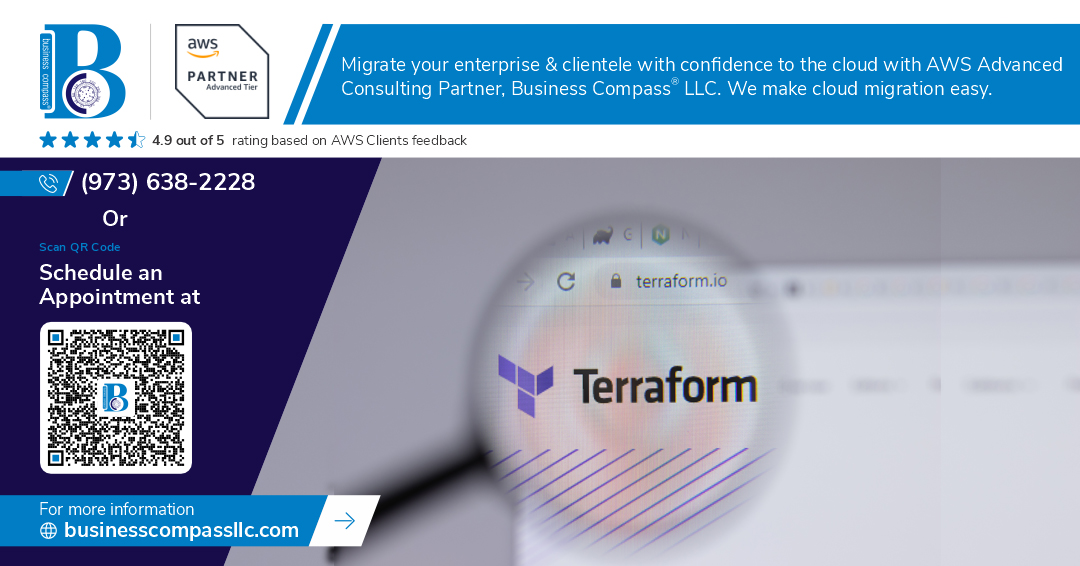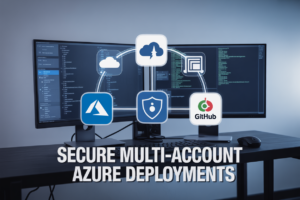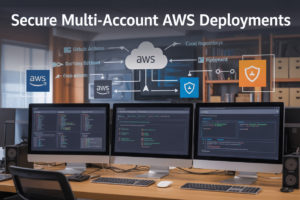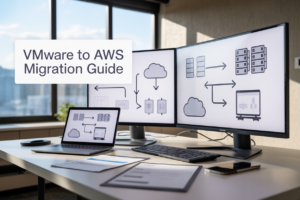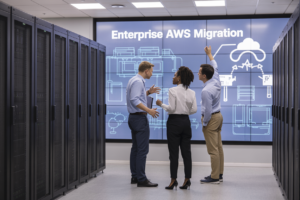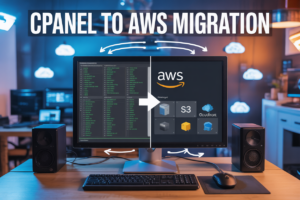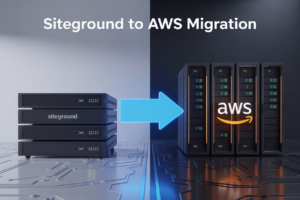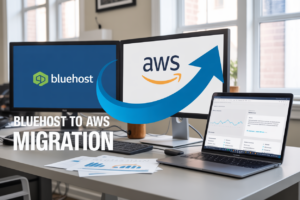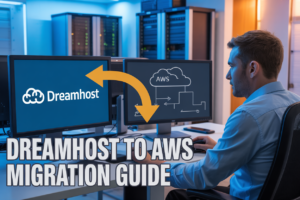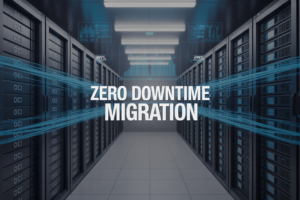Managing infrastructure across multiple AWS accounts and regions can feel overwhelming, but Terraform makes it manageable with the right approach. This comprehensive guide walks you through building a robust multi-account, multi-region infrastructure using Terraform’s most powerful features and proven patterns.
Who this guide is for:
This guide is designed for DevOps engineers, cloud architects, and infrastructure teams who need to scale beyond single-account deployments. You should have basic Terraform experience and understand AWS fundamentals, but we’ll cover the advanced concepts that make multi-account architecture successful.
What you’ll learn:
We’ll start with terraform multi account setup fundamentals, covering architecture design principles that prevent common pitfalls and set your infrastructure up for long-term success. You’ll master terraform state management best practices that keep your deployments organized across accounts and regions without conflicts.
Next, we’ll dive into multi region infrastructure terraform strategies, including provider configuration techniques that handle authentication seamlessly across environments. You’ll discover how to build terraform modules scalability into your infrastructure from day one.
Finally, we’ll cover terraform ci cd pipeline integration and troubleshooting techniques that solve real-world challenges teams face when managing complex multi-account deployments. By the end, you’ll have a complete framework for infrastructure automation terraform that scales with your organization.
Essential Prerequisites and Environment Setup
AWS Account Configuration and IAM Role Requirements
Setting up terraform multi account setup begins with creating dedicated AWS accounts for different environments. Create cross-account IAM roles with appropriate trust relationships, allowing your terraform execution role to assume permissions across accounts. Configure OrganizationAccountAccessRole for seamless access management. Set up least-privilege policies for each environment – development accounts need broader permissions for experimentation, while production requires strict controls. Document your account structure and role hierarchy to maintain security compliance across your multi account architecture design.
Terraform Installation and Version Management Best Practices
Version consistency across teams prevents deployment failures and configuration drift. Use tfenv or terraform version managers to lock specific terraform versions per project. Pin terraform versions in your configuration files using required_version constraints. Maintain separate terraform installations for different projects to avoid conflicts. Keep a version matrix documenting which terraform versions work with your AWS provider versions. Teams should standardize on the same terraform version for collaborative infrastructure as code multi region deployments to ensure reproducible builds.
AWS CLI Setup for Multi-Account Access
Configure named profiles for each AWS account in your credentials file, making cross-account access straightforward. Set up AWS SSO integration when available to centralize authentication across multiple accounts. Use aws configure set commands to define region defaults per profile. Create wrapper scripts that switch between accounts automatically based on your current working directory. Test profile switching with aws sts get-caller-identity to verify correct account access. Store sensitive credentials in AWS Secrets Manager rather than local files for enhanced security in production environments.
Essential Tools and Dependencies for Cross-Region Deployment
Install jq for JSON parsing terraform outputs and AWS CLI responses during automated deployments. Set up pre-commit hooks with terraform fmt and validate commands to catch configuration errors early. Use terraform-docs to automatically generate documentation for your modules. Install checkov or tfsec for security scanning of terraform configurations. Configure terragrunt for managing terraform configurations across multiple environments and regions. Set up proper logging tools like AWS CloudTrail and Config to track infrastructure changes across your terraform cross region deployment pipeline.
Multi-Account Architecture Design Principles
Account Separation Strategies for Production, Staging, and Development
Account-level isolation creates bulletproof boundaries between environments, preventing accidental deployments and limiting blast radius during failures. Production workloads run in dedicated AWS accounts with strict access controls, while staging mirrors production configurations for realistic testing. Development accounts offer flexibility for experimentation without impacting critical systems. This terraform multi account setup approach enables independent billing, granular IAM policies, and complete resource isolation. Teams can deploy infrastructure changes to development first, promote tested configurations to staging, then safely release to production with confidence.
Cross-Account Access Patterns and Security Considerations
Cross-account access requires careful orchestration of IAM roles and trust relationships to maintain security while enabling operational efficiency. AWS cross account patterns include centralized logging accounts that collect CloudTrail and CloudWatch data, shared services accounts hosting DNS and networking components, and security accounts managing compliance tools. Cross-account roles use assume-role patterns with time-limited credentials, while resource-based policies control specific service access. Implementing least-privilege principles means granting minimal permissions needed for each integration, regularly auditing cross-account relationships, and using AWS Organizations SCPs to enforce guardrails across all accounts.
Centralized vs Distributed Infrastructure Management Models
Centralized models consolidate infrastructure as code management through shared Terraform repositories, standardized modules, and unified CI/CD pipelines that deploy across multiple accounts and regions. Platform teams maintain golden templates while application teams consume pre-approved modules, ensuring consistency and compliance. Distributed models give individual teams ownership of their infrastructure code, enabling faster iteration but requiring strong governance frameworks. Hybrid approaches work best, centralizing networking and security foundations while allowing team-specific application infrastructure. The choice impacts terraform state management best practices, module sharing strategies, and overall multi account architecture design complexity.
Multi-Region Strategy and Planning
Region Selection Criteria for High Availability
Choose AWS regions based on proximity to your users, service availability, and compliance requirements. Primary factors include geographical distribution to minimize single points of failure, latency to target audiences, and pricing variations between regions. Consider regions with multiple availability zones and robust infrastructure track records. Your terraform multi region infrastructure should span at least three regions for maximum resilience.
Data Residency and Compliance Requirements Analysis
Data sovereignty laws dictate where customer information can be stored and processed. GDPR requires EU citizen data to remain within specific geographical boundaries, while other regulations like CCPA have different requirements. Map your compliance obligations before designing your multi account architecture. Document data flows between regions and implement appropriate encryption and access controls to meet regulatory standards.
Latency Optimization and User Experience Considerations
Network latency directly impacts user satisfaction and conversion rates. Deploy resources closer to your user base to reduce round-trip times and improve application performance. Use CloudFront or similar CDNs for static content delivery while placing dynamic services in regions serving your largest user populations. Monitor real user metrics to validate your terraform cross region deployment decisions and adjust as needed.
Disaster Recovery and Business Continuity Planning
Design your disaster recovery strategy around Recovery Time Objectives (RTO) and Recovery Point Objectives (RPO). Active-passive configurations offer cost efficiency while active-active setups provide better performance during normal operations. Implement automated failover mechanisms using Route 53 health checks and cross-region replication for critical data stores. Your infrastructure as code multi region approach should include automated backup strategies and recovery procedures.
Terraform State Management Across Accounts and Regions
Remote State Backend Configuration with S3 and DynamoDB
Managing terraform state management best practices across multiple accounts requires a centralized backend that keeps state files secure and accessible. Setting up S3 as your remote backend with DynamoDB for state locking creates a reliable foundation. Create separate S3 buckets for each environment or account to maintain clear boundaries. Configure versioning and encryption on these buckets to protect sensitive infrastructure data. The DynamoDB table handles concurrent access prevention through state locking. Each account should have its own dedicated backend configuration to avoid cross-contamination. Consider using consistent naming conventions like terraform-state-{account-id}-{region} for easy identification. Enable server-side encryption and MFA delete protection on your state buckets to meet security compliance requirements.
State File Isolation Strategies for Multi-Account Environments
Proper state file isolation prevents accidental modifications and maintains clear ownership boundaries across your terraform multi account setup. Structure your state files using a hierarchical approach with separate directories for each account and region combination. Implement workspace-based isolation where each environment gets its own Terraform workspace, creating natural barriers between production and development resources. Use unique backend keys for each deployment unit, typically following patterns like {account}/{region}/{environment}/terraform.tfstate. This approach ensures that changes in one account never accidentally affect resources in another. Set up separate IAM roles and policies that restrict access to specific state files based on the principle of least privilege.
Cross-Account State Sharing and Reference Techniques
When your multi region infrastructure terraform spans multiple accounts, you need reliable methods to share critical information between deployments. Terraform data sources provide clean ways to reference outputs from other state files without creating direct dependencies. Store shared values like VPC IDs, subnet information, and security group references in Systems Manager Parameter Store or AWS Secrets Manager for cross-account access. Use Terraform remote state data sources to pull specific outputs from other accounts while maintaining proper access controls. Create standardized output values in your root modules that other accounts can reliably reference. Consider using AWS Resource Access Manager (RAM) for sharing resources like transit gateways across account boundaries while keeping state files completely separate.
State Locking and Concurrent Access Prevention
DynamoDB state locking prevents corruption when multiple team members or CI/CD pipelines work simultaneously on your terraform aws cross account infrastructure. Configure the DynamoDB table with a primary key named LockID and enable point-in-time recovery for additional protection. Set up proper IAM permissions that allow lock acquisition and release while preventing unauthorized access to the locking mechanism. Monitor lock duration and implement automated cleanup processes for stale locks that might block legitimate operations. Use consistent retry logic in your automation pipelines to handle temporary lock conflicts gracefully. Consider implementing custom lock timeout values based on the complexity of your deployments, with longer timeouts for large multi-region operations.
Provider Configuration and Authentication Methods
AWS Provider Setup for Multiple Accounts
Setting up terraform multi account setup requires careful provider configuration to manage resources across different AWS accounts seamlessly. Each AWS account needs its own provider block with distinct aliases to prevent resource conflicts. The terraform provider configuration supports multiple provider instances through the alias parameter, enabling you to define separate configurations for production, staging, and development accounts. Configure each provider with specific credentials, regions, and account-specific settings to ensure proper resource isolation and management.
provider "aws" {
alias = "production"
region = "us-east-1"
assume_role {
role_arn = "arn:aws:iam::123456789012:role/TerraformRole"
}
}
provider "aws" {
alias = "staging"
region = "us-west-2"
assume_role {
role_arn = "arn:aws:iam::987654321098:role/TerraformRole"
}
}
Cross-Account Role Assumption Configuration
Cross-account role assumption forms the backbone of secure terraform aws cross account deployments. Create dedicated IAM roles in each target account with appropriate trust relationships that allow your central deployment account to assume them. The assume role configuration within provider blocks enables seamless switching between accounts without hardcoding credentials. This approach maintains security boundaries while providing the flexibility needed for multi-account infrastructure management.
Trust policy configuration requires precise setup to ensure only authorized principals can assume roles across accounts:
data "aws_iam_policy_document" "cross_account_trust" {
statement {
actions = ["sts:AssumeRole"]
principals {
type = "AWS"
identifiers = ["arn:aws:iam::${var.deployment_account_id}:root"]
}
condition {
test = "StringEquals"
variable = "sts:ExternalId"
values = [var.external_id]
}
}
}
Region-Specific Provider Aliases and Management
Multi region infrastructure terraform deployments require distinct provider aliases for each region-account combination. Create provider aliases that clearly identify both the account and region to avoid confusion during resource deployment. This naming convention becomes critical when managing dozens of provider configurations across multiple environments and geographical locations.
Organize provider configurations using a systematic naming approach that includes account type and region information:
| Provider Alias | Account | Region | Use Case |
|---|---|---|---|
| prod-us-east-1 | Production | us-east-1 | Primary production resources |
| prod-us-west-2 | Production | us-west-2 | DR and backup systems |
| staging-eu-west-1 | Staging | eu-west-1 | European staging environment |
Credential Management and Security Best Practices
Secure credential management prevents unauthorized access while maintaining operational efficiency in terraform multi account setup environments. Never hardcode AWS access keys in Terraform configurations or version control systems. Instead, leverage IAM roles, AWS profiles, or environment variables for authentication. Implement credential rotation policies and use AWS Secrets Manager or similar services for sensitive configuration data.
Best practices for credential security include:
- Environment Variables: Use
AWS_PROFILEorAWS_ROLE_ARNenvironment variables - IAM Instance Profiles: For EC2-based CI/CD systems
- AWS SSO Integration: Centralized identity management across accounts
- Temporary Credentials: Short-lived tokens through STS assume role
- Least Privilege Access: Grant minimum required permissions for each role
Implement credential validation and rotation mechanisms to maintain security standards:
data "aws_caller_identity" "current" {
provider = aws.production
}
locals {
account_validation = {
production = data.aws_caller_identity.current.account_id == var.production_account_id
}
}
resource "null_resource" "account_validation" {
count = local.account_validation.production ? 0 : 1
provisioner "local-exec" {
command = "echo 'ERROR: Wrong account credentials' && exit 1"
}
}
Modular Infrastructure Design for Scalability
Reusable Module Architecture for Multi-Region Deployment
Building reusable terraform modules scalability requires designing components that work seamlessly across different regions and accounts. Create base modules for common infrastructure patterns like VPCs, security groups, and application tiers that accept region-specific parameters. Structure your modules with clear input variables for region codes, availability zones, and naming conventions. Each module should handle region-specific resources like AMIs and availability zone mapping internally. Design modules to be stateless and avoid hardcoded values that tie them to specific regions. Use data sources to dynamically fetch region-appropriate resources like the latest AMI IDs or available instance types. This approach enables rapid multi region infrastructure terraform deployment while maintaining consistency across your infrastructure landscape.
Variable Management Across Environments and Regions
Managing variables across multiple environments and regions demands a structured approach that prevents configuration drift. Implement a hierarchical variable structure using tfvars files organized by environment and region combinations. Create separate variable files for global settings, environment-specific configurations, and region-specific overrides. Use Terraform workspaces or directory structures to isolate configurations while sharing common variable definitions. Leverage variable validation rules to ensure consistency across deployments and prevent invalid configurations. Store sensitive variables in external systems like AWS Parameter Store or HashiCorp Vault, referencing them through data sources. This strategy maintains clean separation between environments while enabling easy replication of configurations across new regions or accounts.
Module Versioning and Dependency Management
Proper module versioning prevents breaking changes from disrupting your multi-account infrastructure deployments. Tag your modules with semantic versioning and store them in version control repositories or Terraform registries. Pin module versions in your root configurations to ensure reproducible deployments across all environments. Create a module release process that includes testing in development environments before promoting to production. Use Terraform’s module upgrade workflows to test compatibility before updating versions. Maintain backward compatibility when possible, and provide clear migration guides for breaking changes. Document module dependencies and compatibility matrices to help teams choose appropriate versions. This disciplined approach to versioning ensures stable, predictable deployments while allowing controlled evolution of your infrastructure components.
Environment-Specific Configuration Strategies
Different environments require tailored configurations while maintaining consistent patterns across your terraform multi account setup. Implement environment-specific sizing, security rules, and feature flags through configuration files rather than separate codebases. Use conditional logic within modules to enable or disable features based on environment variables. Create environment-specific locals and variables that adjust resource configurations like instance sizes, backup retention, and monitoring levels. Establish naming conventions that include environment and region identifiers to avoid resource conflicts. Configure different provider aliases for various account and region combinations within the same Terraform configuration. This approach reduces code duplication while ensuring each environment gets appropriate configurations for its intended purpose and compliance requirements.
Network Architecture Across Accounts and Regions
VPC Design Patterns for Multi-Account Environments
Building a robust multi account network architecture requires careful planning of VPC design patterns that scale across different AWS accounts. The hub-and-spoke model works best for terraform multi account setup, where a central networking account hosts shared services while workload accounts maintain isolated environments. Each account should contain region-specific VPCs with standardized CIDR blocks to prevent IP conflicts during cross-account connectivity. Design your VPC architecture with dedicated subnets for different tiers – public subnets for load balancers, private subnets for application servers, and isolated subnets for databases. This pattern ensures clean separation while enabling controlled communication between accounts through well-defined network boundaries.
Cross-Account VPC Peering and Transit Gateway Implementation
AWS Transit Gateway revolutionizes multi account network architecture by eliminating the complexity of managing multiple VPC peering connections. Instead of creating a mesh of peering relationships, Transit Gateway acts as a central hub that connects VPCs across different accounts and regions. Configure Transit Gateway using Terraform modules that handle cross-account sharing and route table management automatically. VPC peering still has its place for simple point-to-point connections between specific accounts, but Transit Gateway offers superior scalability and routing control. When implementing cross-account connectivity, create dedicated Terraform configurations that manage resource sharing policies and ensure proper authentication between accounts. The key advantage lies in centralized routing control and simplified network topology management.
Multi-Region Connectivity and Network Routing
Establishing connectivity between regions requires strategic planning of network routing and bandwidth considerations. Transit Gateway Inter-Region Peering provides encrypted connections between regions while maintaining high availability and performance. Your terraform cross region deployment should include backup routing paths and failover mechanisms to handle regional outages gracefully. Design your routing tables to prioritize local traffic within regions while allowing controlled cross-region communication for disaster recovery scenarios. Consider implementing Route 53 Resolver for DNS resolution across regions, enabling applications to discover services regardless of their geographic location. Network latency and data transfer costs become critical factors when designing multi-region connectivity, so implement routing policies that optimize both performance and expenses.
Security Group and NACL Management at Scale
Managing security groups and Network Access Control Lists (NACLs) across multiple accounts and regions requires a systematic approach using Terraform modules. Create standardized security group templates that define common access patterns – web tier, application tier, and database tier security groups with predefined rules. Use Terraform data sources to reference security groups across accounts, enabling dynamic rule creation based on resource discovery. NACLs provide subnet-level protection and should complement security group rules rather than duplicate them. Implement a naming convention that clearly identifies the account, region, and purpose of each security group to maintain clarity at scale. Consider using AWS Config rules to monitor security group compliance and detect unauthorized changes. The combination of well-structured Terraform modules and consistent security policies ensures your multi account network architecture remains secure and manageable as it grows.
Deployment Automation and CI/CD Integration
Pipeline Design for Multi-Account Infrastructure Changes
Building a robust terraform ci cd pipeline for multi-account deployments requires careful orchestration across environments. The pipeline should treat each account as a separate deployment target with distinct approval gates and validation steps. Start with a hub-and-spoke model where your CI/CD system sits in a central DevOps account and assumes roles in target accounts. Use branch-based workflows where development changes trigger plans against dev accounts, while production deployments require explicit approvals and tagging.
Design your pipeline stages to handle terraform state management best practices by isolating state files per account and region combination. Configure separate backend configurations for each environment, preventing cross-contamination between accounts. The pipeline should automatically select the correct provider configuration based on the target account, switching between different AWS profiles or role assumptions seamlessly.
Implement parallel execution strategies for multi region infrastructure terraform deployments when changes don’t have cross-region dependencies. This approach significantly reduces deployment time while maintaining safety through proper ordering of interdependent resources. Use pipeline artifacts to pass terraform plans between stages, ensuring consistency between plan and apply operations across all target accounts.
Approval Workflows and Change Management Processes
Effective change management becomes critical when dealing with terraform multi account setup scenarios. Design approval workflows that match your organization’s risk tolerance – production accounts should require multiple approvers, while development environments can have automated approvals for trusted team members. Implement role-based access control where infrastructure teams can approve networking changes but require security team sign-off for IAM modifications.
Create approval matrices based on the scope and impact of changes. Small configuration adjustments might only need a single approval, while large-scale infrastructure modifications or new account deployments should trigger comprehensive review processes. Use pull request reviews as your first line of defense, requiring infrastructure peers to validate terraform configurations before they enter the pipeline.
Set up notification systems that alert stakeholders about pending changes across accounts. Include change summaries, affected resources, and estimated deployment times in approval requests. This transparency helps approvers make informed decisions quickly while maintaining security standards. Configure emergency bypass procedures for critical production fixes, but ensure these are logged and reviewed afterwards.
Automated Testing and Validation Strategies
Comprehensive testing strategies for multi-account terraform deployments should include multiple validation layers. Start with static analysis using tools like tflint and terraform validate to catch syntax errors and policy violations early. Implement custom policy checks using Open Policy Agent or Sentinel to enforce your organization’s infrastructure standards across all accounts and regions.
Deploy infrastructure automation terraform testing in isolated sandbox accounts that mirror your production setup. These test environments should use identical terraform modules and configurations but with reduced resource sizes to minimize costs. Run integration tests that validate cross-account networking, IAM role assumptions, and service connectivity after each deployment.
Use contract testing to verify that your terraform modules produce expected outputs across different account configurations. This approach catches breaking changes before they impact dependent infrastructure. Implement drift detection by regularly running terraform plan against existing infrastructure and alerting on unexpected changes. Schedule periodic compliance scans to ensure deployed resources continue meeting security and governance requirements across your entire multi-account landscape.
Monitoring, Logging, and Cost Optimization
Centralized Logging and Monitoring Setup Across Accounts
Building a unified observability layer across your multi-account infrastructure requires strategic aggregation of logs and metrics. CloudWatch cross-account log destinations let you stream logs from production workloads to a dedicated monitoring account, while AWS Config aggregators collect compliance data. Set up centralized dashboards using CloudWatch or third-party tools like Datadog to visualize performance across all accounts. Use IAM cross-account roles to grant monitoring services read access to resources without compromising security boundaries.
Resource Tagging Strategies for Cost Allocation
Consistent tagging across accounts enables accurate cost allocation and chargeback mechanisms. Implement mandatory tags like Environment, Project, Owner, and CostCenter through AWS Organizations Service Control Policies. Create Terraform variables for standardized tag sets and enforce them across all resources using provider-level default tags. Use AWS Cost Categories to group resources by business units or teams, and leverage Cost Explorer to track spending patterns. Automate tag compliance checks with AWS Config rules to catch untagged resources before they impact your billing visibility.
Multi-Region Performance Monitoring and Alerting
Regional performance monitoring requires distributed health checks and intelligent alert routing. Deploy CloudWatch Synthetics canaries in each region to monitor application endpoints and API response times. Configure Route 53 health checks with failover routing to detect regional outages automatically. Set up cross-region CloudWatch alarms that trigger SNS notifications to appropriate on-call teams based on geographic responsibility. Use AWS X-Ray for distributed tracing across regions to identify performance bottlenecks in multi-region applications and optimize data transfer costs.
Cost Optimization Techniques for Multi-Account Infrastructure
Multi-account environments offer unique opportunities for terraform cost optimization through centralized purchasing and resource sharing. Enable AWS Organizations consolidated billing to leverage volume discounts and Reserved Instance sharing across accounts. Use AWS Trusted Advisor recommendations to identify underutilized resources and right-size instances. Implement automated shutdown schedules for development environments using Lambda functions triggered by CloudWatch Events. Set up billing alerts and budget controls at both account and organizational levels to prevent unexpected spending spikes across your multi-account infrastructure.
Troubleshooting Common Multi-Account Challenges
Permission and Access Issues Resolution
Cross-account IAM permissions create the most frustrating roadblocks in terraform multi account setup deployments. Start by checking AssumeRole policies and trust relationships between accounts – these break silently when resource ARNs don’t match expected patterns. Use aws sts get-caller-identity to verify your current identity before running Terraform commands. Enable CloudTrail across all accounts to track permission failures in real-time. When terraform aws cross account operations fail, examine the provider configuration for correct role ARNs and external IDs. Set up least-privilege policies with specific resource constraints rather than wildcards. Create dedicated deployment roles for each account with clearly defined boundaries. Test permissions manually using AWS CLI before automating through Terraform.
State Corruption and Recovery Procedures
Terraform state corruption happens when multiple team members modify infrastructure simultaneously across regions or accounts. Enable S3 versioning and point-in-time recovery for your state buckets immediately. When corruption occurs, compare the current state with your last known good backup using terraform show commands. Never edit state files directly – use terraform state commands for safe modifications. Create automated state backups before every major deployment using pre-apply hooks. For terraform state management best practices, implement state locking with DynamoDB to prevent concurrent modifications. Recovery involves restoring from backup, then running targeted imports to reconcile any resource drift. Keep separate state files for each account-region combination to minimize blast radius when issues occur.
Cross-Region Resource Dependencies Management
Dependencies between regions create complex chains that break during partial failures or network issues. Map all cross-region dependencies before designing your terraform multi region infrastructure – VPC peering, Route53 zones, and shared KMS keys need careful orchestration. Use data sources instead of direct resource references when possible to reduce coupling. Implement retry logic and exponential backoff for cross-region API calls that experience eventual consistency delays. Create explicit ordering with depends_on attributes for critical resource creation sequences. When regions become temporarily unavailable, Terraform can’t validate remote state, causing deployment failures. Plan for graceful degradation by making cross-region dependencies optional where business logic allows. Use local values and conditional expressions to handle missing remote resources during disaster scenarios.
Building a robust multi-account, multi-region infrastructure with Terraform requires careful planning and execution across multiple dimensions. From setting up your environment and designing your architecture to managing state files and configuring providers, each component plays a critical role in creating a scalable and maintainable system. The modular approach to infrastructure design, combined with proper network architecture and automated deployment processes, forms the backbone of successful enterprise-level cloud operations.
The journey doesn’t end with deployment – ongoing monitoring, cost optimization, and troubleshooting are essential for long-term success. Start small with a pilot project to test your multi-account strategy, then gradually expand your infrastructure as you gain confidence and refine your processes. Remember to leverage Terraform’s built-in features for state management and embrace automation through CI/CD pipelines to reduce manual errors and improve consistency across your environments.










